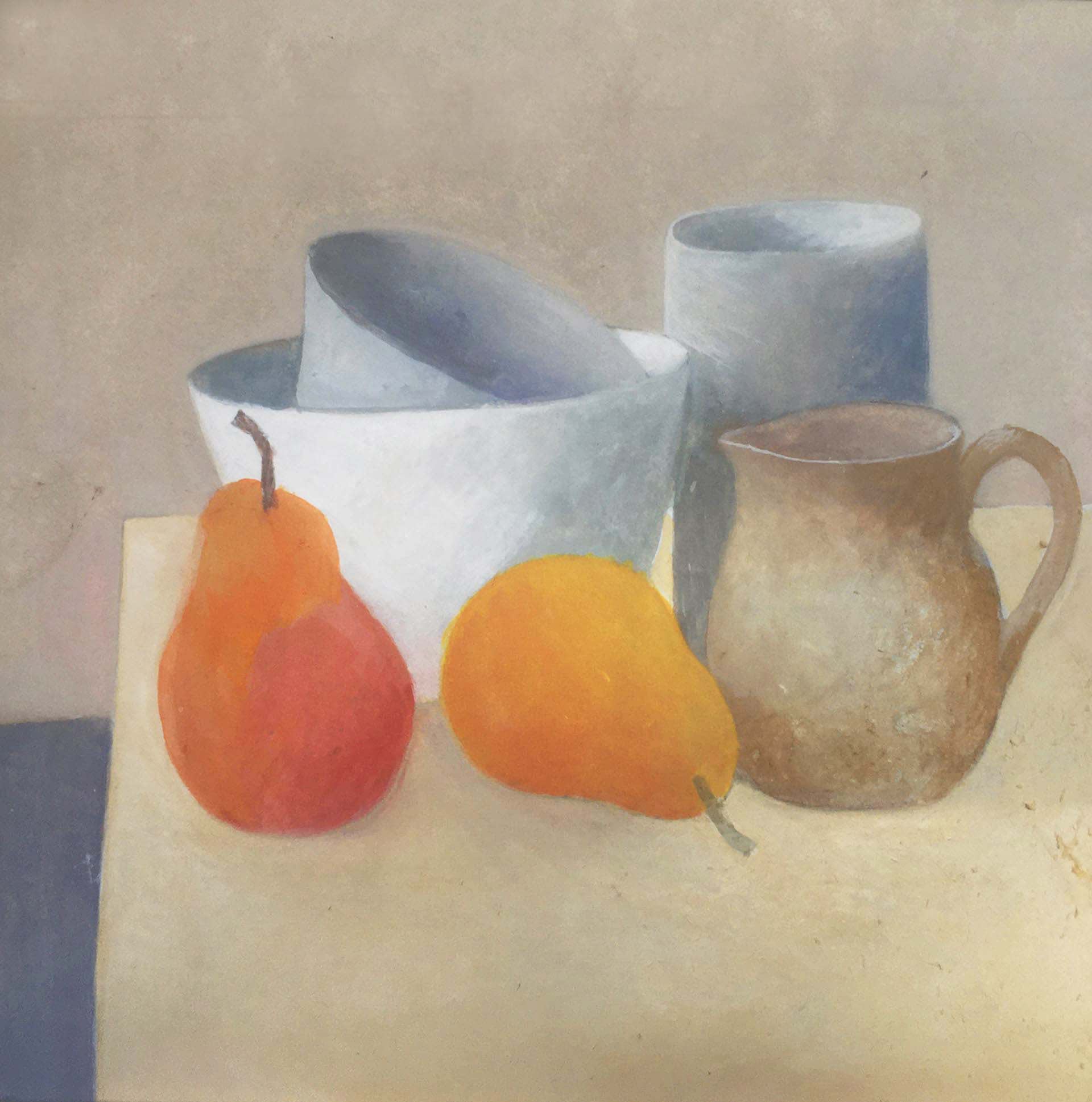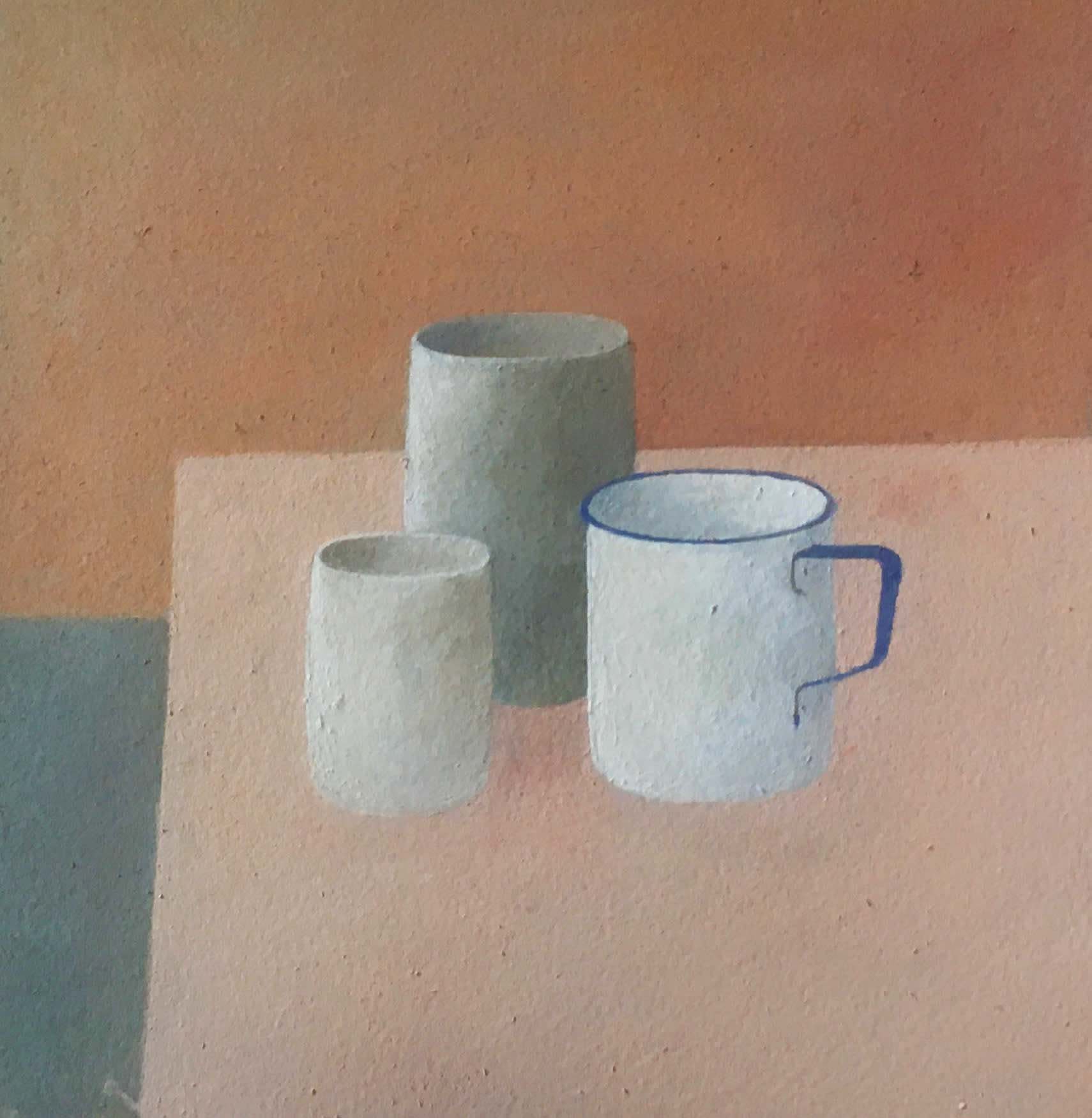Wendy Jacob RWS paints almost exclusively in gouache, an opaque form of the traditionally translucent watercolour. Her work explores the everyday and the domestic, bringing a graphic vitality to even the most ordinary scenes.
Early artistic education has the habit of deeply affecting an artist and in this, Wendy is no different: “I always loved drawing as a child – at home and at school. Fortunately, my seriously academic secondary school also had a very good Art Department where Peggy Angus, a close friend of Ravilious, was in charge. I went on to Hammersmith School of Art where Ruskin Spear taught an evening life painting class, and Bernard Cohen ran the Basic Design course based on the Paul Klee teachings at the Bauhaus.”
These early introductions to figures of such great artistic influence had a profound impact on Wendy, who continued her education at Hammersmith, going on to complete a course in Mural Design – a multi-media course, which included stained glass, painting in both tempura and oil, mosaics and even some plastic moulding. One can see the particular influence of stained glass and mosaic in Wendy’s current practice where defined shapes are brought together using strong flat colour and line to create a scene where decorative qualities are favoured over realism. However, she says that it was the drawing skills that she acquired during these years that she would come to rely on most heavily.
After graduating in 1963, Wendy entered the world of work and was approached by a friend who was looking for an artist to produce a hundred small drawings for a design company catalogue – Goods and Chattels. The fee was a pound for each drawing (they had approached David Gentleman, who was very well known then, as now, who had asked for much more.) This led to a similar commission from Habitat, so gradually a portfolio was created and Wendy was able to find an agent who provided her with regular illustration work for magazines, newspapers and publishers.
After a number of years in the industries of illustration and publication, Wendy began to feel drawn towards a less obviously commercial form of working: “Rupert Murdoch’s revolution in Fleet Street changed the commissioning structure for this work. It was no longer such an attractive prospect, so painting began to take precedence.”

Wendy Jacob RWS, Two Pears and Four Pots, gouache, £390 unframed. Shop here.
After the relatively confined nature of illustrative work, Wendy was keen to explore the world around her and work in landscape: “Often I would take the finished work back to the subject, finding that I needed more specific information in terms of tone, pattern and structure. On my painting outings, I came across some wonderfully wayward leaning fences and I realised I had stumbled across a subject that I would return to again and again. Now I search them out and go on fence hunting expeditions.”
When Wendy began painting full time, elements of her working lifestyle as a freelance illustrator were transferred to her professional painting practice; the input of a deadline was key to her routine and in order to maintain a structure she entered as many open competitions as possible including the Sunday Times Competition, New English Art Club, RWS, RI and The Discerning Eye. She says of that period: “My attitude was that acceptance was great but rejection did not depress me. I used it as a learning process: it made me look harder at what I had sent in – and at the work that had been accepted for that exhibition.” This is where her association with the RWS began, resulting with Election in 2005.
Soon after election to the RWS, Wendy also began to teach at West Dean Collect, West Sussex, where she returned to still life, a subject she had avoided, believing it to be too close to her illustration practice. Wendy says of the genre, now so much a part of her practice: “It is a good subject for a teaching tool as everyone has something before them to paint and a common task bonds the class. For me still life provides an opportunity for experimentation and offers a kind of Zen experience. Having very carefully created the arrangement, which involves thinking hard about the colours and shapes of the objects and background and their position in relation to the fall of the light, you are at a wonderful starting point. Then, while nudging the drawing into place and adjusting the tone and colour, the painting takes over and it becomes something else – not just a transcription of what is there but a condensed version of the visual experience. It is a very mysterious process.”
A preference for gouache came after initially beginning to paint in traditional watercolour: “I frequently used gouache to rescue watercolour paintings that had gone wrong and found a medium that suited my method of feeling my way into a painting. I now feel so comfortable working in gouache that I would not return to the anxiety and tensions of working in pure watercolour. The vibrant, dense colours of gouache are a great joy and the wonderful thing is that you can over-paint and change a painting right up to the moment before it goes into a frame. Sometimes paintings that come back to the studio much later come out of frames to be changed. A painting is only finished for now – in six months I may have a different view.”
Wendy’s inspiration and stimulation comes from everyday life, home and travel, but London, the city in which she lives, remains a subject she has not yet confronted. That is not to say that she doesn’t enjoy the huge number of galleries and artists the city is home to: “I am fascinated to see how different artists achieve resolution in their work. Painting is a solitary activity and sometimes sitting alone in the studio, you miss interaction with other artists. This is when I head off to a gallery and come back refreshed, returning to the studio with a range of solutions to artistic problems and the knowledge that there are no limits to what can be achieved in paint.”

Wendy Jacob RWS, Still Life Against a Terracotta Wall, gouache, £390 unframed. Shop here.
As previously mentioned, Wendy was elected as an Associate Member of the RWS in 2005. Her membership has been one of many opportunities taken and events organized. Not only was Wendy Vice President of the RWS for three years but she has also taken art education to the heart of the Society’s mission statement. The bi-annual Education Programme that she designed and ran until 2018, has enabled a wider audience to reach the wonderful world of watercolour through public lectures, family art events and practical workshops and it has required watercolour to be seen in a new and relevant contemporary light.
Her still life practice, together with a home studio filled with much loved objects, proved to be a great benefit during lockdown. Although missing the stimulus of meeting artist friends and visits to galleries, the daily routine of regular work in the studio was normal and it proved to be a very useful time for contemplative painting.
If you would like to find out more about Wendy, you can follow her on Instagram or visit her website here. You can also browse more of her artworks through the button below!
More like this on the Blog...
Read: Stop to Think: Interview with Gerry Baptist RWS RE
Read: Landscape and Light: Interview with Richard Pikesley RWS
Read: Interview with Gertie Young RWS
Read: Interview with Jill Leman PRWS
Read: The Poetry of the Everyday: Interview with Anita Klein PPRE Hon. RWS
Read: Interview with Akash Bhatt RWS



